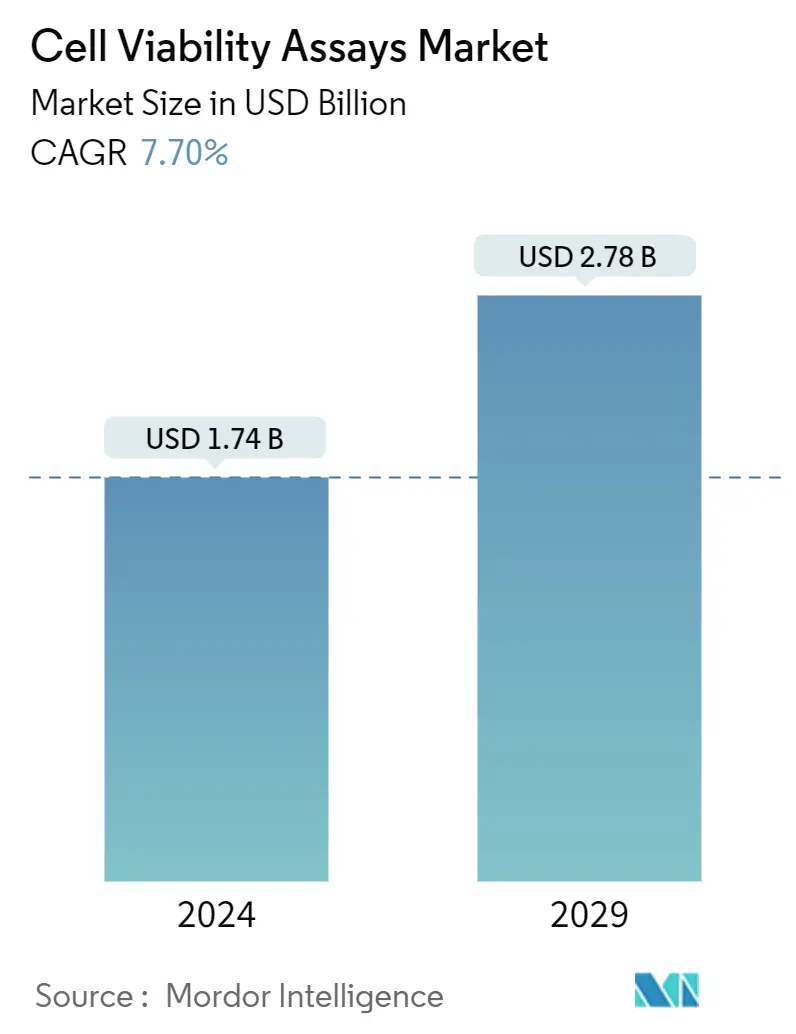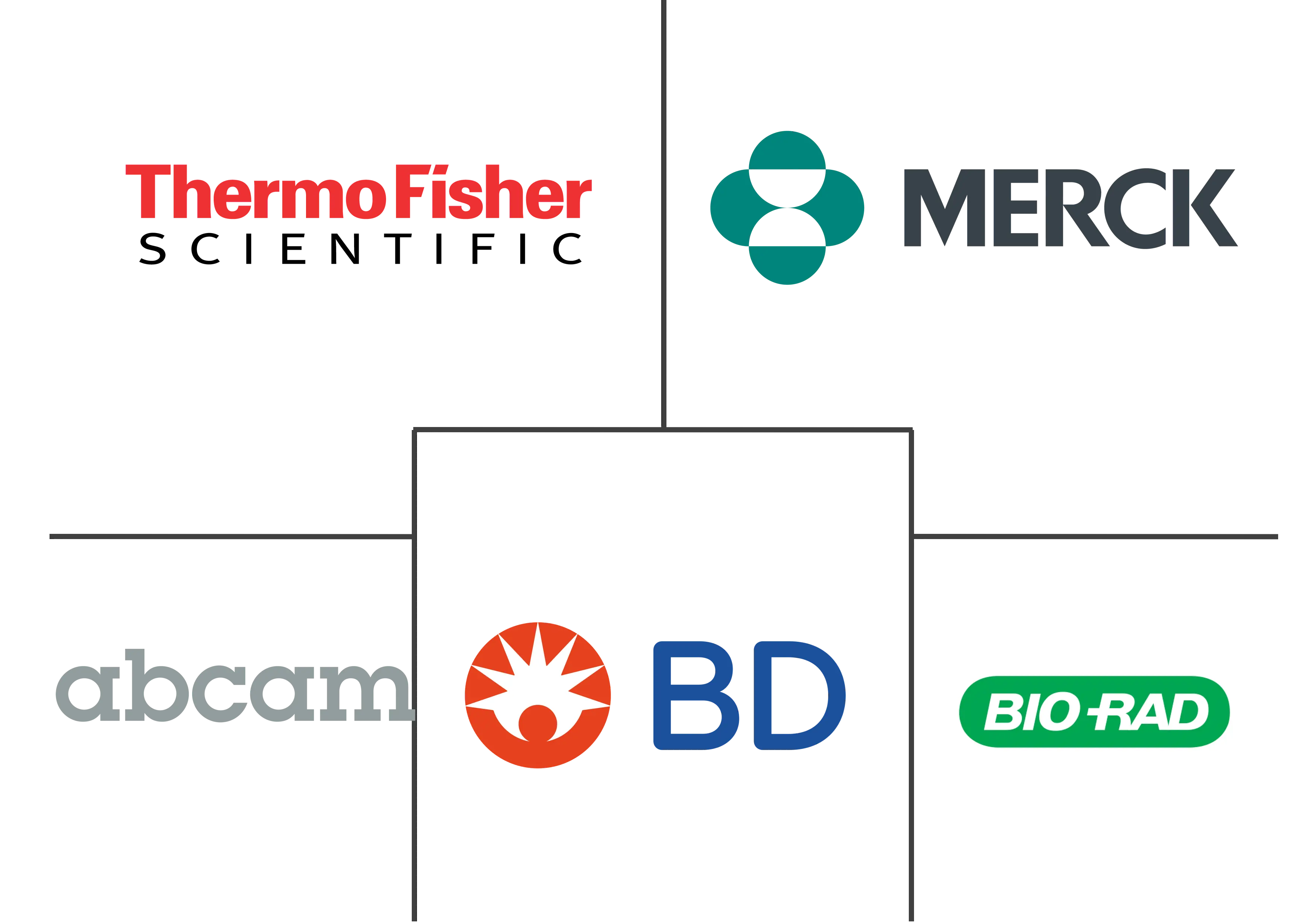Market Size of Cell Viability Assays Industry

| Study Period | 2019 - 2029 |
| Market Size (2024) | USD 1.74 Billion |
| Market Size (2029) | USD 2.78 Billion |
| CAGR (2024 - 2029) | 7.70 % |
| Fastest Growing Market | Asia Pacific |
| Largest Market | North America |
Major Players
*Disclaimer: Major Players sorted in no particular order |
Cell Viability Assays Market Analysis
The Cell Viability Assays Market size is estimated at USD 1.74 billion in 2024, and is expected to reach USD 2.78 billion by 2029, growing at a CAGR of 7.70% during the forecast period (2024-2029).
The COVID-19 pandemic significantly impacted the growth of the cell viability assay market, as most companies focused on developing cell-based therapies for COVID-19 treatment. For instance, according to the study published in Stem Cell Research & Therapy volume in January 2022, stem cell therapy and stem cell-derived organoid models got much attention as a new treatment and research method for COVID-19, and stem cells played a role in the battle against COVID-19. With the increase in the need for stem cell therapies, there was to be an increase in the need for cell viability assays; hence, the market grew during the pandemic. However, as the pandemic has subsided, the studied market is expected to have stable growth during the forecast period of the study.
Factors such as the growing burden of chronic and infectious diseases, rising demand for cell-based assays in research, and increasing focus on developing cell-based therapeutics drive global market growth. Moreover, chronic diseases and conditions are on the rise worldwide, which is expected to further enhance the usage of cell viability assays. As per the International Diabetes Federation Diabetes Altas, in 2021, nearly 573 million adults were living with diabetes worldwide, and the number is expected to reach 643 million by 2030 and 783 million by 2045. As chronic disorders are on the rise, there is a huge demand for assays, which are helping in the faster treatment and timely detection of patients' conditions.
In emerging markets, cancer and heart diseases are becoming the main causes of death due to urbanization, sedentary lifestyles, changing diets, rising obesity levels, and widespread availability of tobacco products. For instance, according to an article published by PubMed Central in March 2022, China is experiencing a greater incidence of cancers. In 2022, there were expected to be approximately 4,820,000 new cancer cases in China, of which the most common is lung cancer. Hence, the high prevalence of chronic diseases such as cancer is expected to boost the adoption of cell viability assays to develop more innovative drugs.
Moreover, developing new cell viability assays to meet the rising demand is also a major factor driving the market growth. For instance, according to an article published by PubMed Central in May 2022, a novel cell viability assay was developed, which can check cellular viability in real-time using supervised machine learning and intracellular dynamic activity data acquired in a label-free, non-invasive, and non-destructive manner. Thus, the rising developments, such as novel cell viability assays, are also expected to boost market growth.
However, the limitations of the assays are expected to impede the market growth.
Cell Viability Assays Industry Segmentation
As per the scope of this report, a cell viability assay is used to determine the ability of organs, cells, or tissues to maintain or recover viability. This type of assay can check the mechanical activity, motility, contraction, etc. Counting cells using viability dyes can provide both the proliferation rate and the percentage of viable cells. The cell viability assays market is segmented by product (consumables (reagents, assay kits, and other consumables), instruments (automated cell counters, flow cytometers, spectrophotometers, and other instruments)), application (drug discovery and development, stem cell research, clinical and diagnostic applications, and other applications), and geography (North America, Europe, Asia-Pacific, Middle-East and Africa, and South America). The market report also covers the estimated market sizes and trends for 17 countries across major global regions. The report offers the value (in USD) for the above segments.
| By Product | ||||||
| ||||||
|
| By Application | |
| Drug Discovery and Development | |
| Stem Cell Research | |
| Clinical and Diagnostic Applications | |
| Other Applications |
| Geography | ||||||||
| ||||||||
| ||||||||
| ||||||||
| ||||||||
|
Cell Viability Assays Market Size Summary
The cell viability assays market is poised for significant growth over the forecast period, driven by the increasing demand for cell-based assays in research and the rising burden of chronic and infectious diseases. The market experienced a boost during the COVID-19 pandemic as companies focused on developing cell-based therapies, which heightened the need for cell viability assays. As the pandemic's impact wanes, the market is expected to stabilize and continue its upward trajectory. The prevalence of chronic conditions, such as diabetes and cancer, particularly in emerging markets, is expected to further propel the adoption of these assays. Technological advancements and the development of novel assays, including those utilizing machine learning for real-time viability checks, are also contributing to market expansion.
North America holds a dominant position in the cell viability assays market, supported by a robust infrastructure for clinical and laboratory research, increased government investment, and a high incidence of chronic diseases. The United States, in particular, is witnessing a rise in cancer cases and corresponding research funding, which is expected to drive market growth. Strategic collaborations, such as those between Promega Corporation and FUJIFILM Cellular Dynamics, are enhancing assay development for drug discovery. The market is characterized by fragmentation and competitiveness, with key players like Thermo Fischer Scientific Inc., Merck KGaA, and Bio-Rad Laboratories actively contributing to innovation and expansion.
Cell Viability Assays Market Size - Table of Contents
-
1. MARKET DYNAMICS
-
1.1 Market Overview
-
1.2 Market Drivers
-
1.2.1 Growing Burden of Chronic and Infectious Diseases
-
1.2.2 Rising Demand for Cell-based Assays in Research
-
1.2.3 Increasing Focus on the Development of Cell-based Therapeutics
-
-
1.3 Market Restraints
-
1.3.1 Limitations of the Assays
-
-
1.4 Porter's Five Forces Analysis
-
1.4.1 Bargaining Power of Buyers/Consumers
-
1.4.2 Bargaining Power of Suppliers
-
1.4.3 Threat of New Entrants
-
1.4.4 Threat of Substitute Products
-
1.4.5 Intensity of Competitive Rivalry
-
-
-
2. MARKET SEGMENTATION (Market Size by Value - USD)
-
2.1 By Product
-
2.1.1 Consumables
-
2.1.1.1 Reagents
-
2.1.1.2 Assay Kits
-
2.1.1.3 Other Consumables
-
-
2.1.2 By Instruments
-
2.1.2.1 Automated Cell Counters
-
2.1.2.2 Flow Cytometers
-
2.1.2.3 Spectrophotometers
-
2.1.2.4 Other Instruments
-
-
-
2.2 By Application
-
2.2.1 Drug Discovery and Development
-
2.2.2 Stem Cell Research
-
2.2.3 Clinical and Diagnostic Applications
-
2.2.4 Other Applications
-
-
2.3 Geography
-
2.3.1 North America
-
2.3.1.1 United States
-
2.3.1.2 Canada
-
2.3.1.3 Mexico
-
-
2.3.2 Europe
-
2.3.2.1 Germany
-
2.3.2.2 United Kingdom
-
2.3.2.3 France
-
2.3.2.4 Italy
-
2.3.2.5 Spain
-
2.3.2.6 Rest of Europe
-
-
2.3.3 Asia-Pacific
-
2.3.3.1 China
-
2.3.3.2 Japan
-
2.3.3.3 India
-
2.3.3.4 Australia
-
2.3.3.5 South Korea
-
2.3.3.6 Rest of Asia-Pacific
-
-
2.3.4 Middle East and Africa
-
2.3.4.1 GCC
-
2.3.4.2 South Africa
-
2.3.4.3 Rest of Middle East and Africa
-
-
2.3.5 South America
-
2.3.5.1 Brazil
-
2.3.5.2 Argentina
-
2.3.5.3 Rest of South America
-
-
-
Cell Viability Assays Market Size FAQs
How big is the Cell Viability Assays Market?
The Cell Viability Assays Market size is expected to reach USD 1.74 billion in 2024 and grow at a CAGR of 7.70% to reach USD 2.78 billion by 2029.
What is the current Cell Viability Assays Market size?
In 2024, the Cell Viability Assays Market size is expected to reach USD 1.74 billion.

